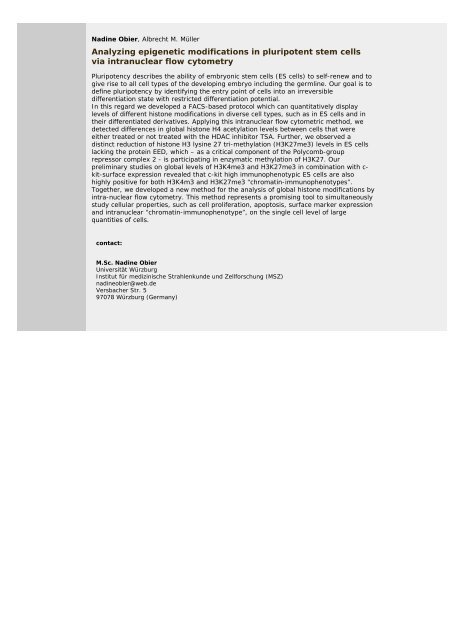Abstracts (poster) - Wissenschaft Online
Abstracts (poster) - Wissenschaft Online
Abstracts (poster) - Wissenschaft Online
You also want an ePaper? Increase the reach of your titles
YUMPU automatically turns print PDFs into web optimized ePapers that Google loves.
Nadine Obier, Albrecht M. Müller<br />
Analyzing epigenetic modifications in pluripotent stem cells<br />
via intranuclear flow cytometry<br />
Pluripotency describes the ability of embryonic stem cells (ES cells) to self-renew and to<br />
give rise to all cell types of the developing embryo including the germline. Our goal is to<br />
define pluripotency by identifying the entry point of cells into an irreversible<br />
differentiation state with restricted differentiation potential.<br />
In this regard we developed a FACS-based protocol which can quantitatively display<br />
levels of different histone modifications in diverse cell types, such as in ES cells and in<br />
their differentiated derivatives. Applying this intranuclear flow cytometric method, we<br />
detected differences in global histone H4 acetylation levels between cells that were<br />
either treated or not treated with the HDAC inhibitor TSA. Further, we observed a<br />
distinct reduction of histone H3 lysine 27 tri-methylation (H3K27me3) levels in ES cells<br />
lacking the protein EED, which – as a critical component of the Polycomb-group<br />
repressor complex 2 - is participating in enzymatic methylation of H3K27. Our<br />
preliminary studies on global levels of H3K4me3 and H3K27me3 in combination with ckit-surface<br />
expression revealed that c-kit high immunophenotypic ES cells are also<br />
highly positive for both H3K4m3 and H3K27me3 “chromatin-immunophenotypes”.<br />
Together, we developed a new method for the analysis of global histone modifications by<br />
intra-nuclear flow cytometry. This method represents a promising tool to simultaneously<br />
study cellular properties, such as cell proliferation, apoptosis, surface marker expression<br />
and intranuclear “chromatin-immunophenotype”, on the single cell level of large<br />
quantities of cells.<br />
contact:<br />
M.Sc. Nadine Obier<br />
Universität Würzburg<br />
Institut für medizinische Strahlenkunde und Zellforschung (MSZ)<br />
nadineobier@web.de<br />
Versbacher Str. 5<br />
97078 Würzburg (Germany)

















